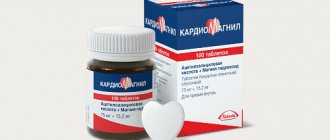The postpartum recovery period is often accompanied by painful manifestations associated with cardiac dysfunction.
To relieve discomfort, young mothers use Corvalol while breastfeeding, without thinking about the possibility of the drug’s negative effects on the baby’s body.
Information from this article will help you draw the correct conclusion about the advisability of using this drug, assess the degree of benefit for a nursing mother and the level of harm caused to the child.
Description of the drug
Corvalol is an excellent sedative (calming) drug, which at the same time has a beneficial antispasmodic effect.
With its help, it is possible to relieve pain in the heart area and stabilize the state of the nervous system.
Having the ability to relieve the effects of physical and emotional stress, the drug eliminates difficulties with falling asleep.
Compound
Of the active ingredients, the medicine contains the following components:
- Phenobarbital. Helps eliminate anxiety, excessive excitability, and normalize sleep.
- Valerian officinalis. It has a calming effect, as a result of which it eliminates vascular spasms.
- Peppermint. Leads to the relief of spasms in the vessels of the heart, expanding their lumens. Significantly improves intestinal motility.
Considering the positive characteristics of the drug and the seemingly harmless substances it contains, some women take Corvalol without first consulting a doctor. At the same time, they do not take into account how dangerous this is for the health of the baby.
Can a nursing mother take Corvalol?
Corvalol is used for heart pain and emotional turmoil , but its composition is not at all harmless, and may force you to remove the drug from your personal medicine cabinet.
Phenobarbital contained in Corvalol belongs to the group of Barbiturates and has a nonspecific inhibitory effect on the nervous system. In addition to sedative and tranquilizing effects, the drug has vasodilating and antispasmodic effects. It tends to cause drug addiction with prolonged uncontrolled use, and, if the maximum dose is exceeded, it can deeply suppress the functioning of the central nervous system (CNS) and respiration.
Indications for use
Corvalol has a beneficial effect on the nervous system. This becomes a prerequisite for its use in such clinical situations as:
- Conditions associated with manifestations of tachycardia or arrhythmia caused by cardiac rhythm disturbances.
- Vascular dystonia, occurring with disturbances in blood pressure and rapid heartbeat.
- Diseases of the nervous system that provoke frequent headaches (migraines), anxiety, irritability, excessive emotional excitability, insomnia.
- Pathological processes associated with disruption of the gastrointestinal tract and accompanied by cramps, flatulence, and bloating.
It should be noted that the drug is used as one of the components of complex treatment. Its effect is fast, but short-lived, so using Corvalol alone will not eliminate the cause of the disease, but will only relieve significant symptoms.
The effect of the drug on the body and its composition
Corvalol is the most common drug with a sedative (calming) effect on the body. Contrary to popular belief, Corvalol does not directly affect the heart, but has a calming effect on the entire nervous system. The medication consists of the following active ingredients: filtered water, phenobarbital, isovaleric esters and peppermint oil. The components of Corvalol affect many human neurological diseases. Taking Corvalol is indicated for the following problems:
- disorder of the cardiovascular system (tachycardia, arrhythmia);
- suspiciousness, hypochondria, irritability, insomnia;
- low persistent increase in blood pressure, vegetative-vascular dystonia;
- spasms of the intestinal muscles.
Typically, this medication is prescribed as an auxiliary treatment for the problems listed above. "Corvalol" serves to enhance the overall effect of therapy and is able to quickly stop an acute attack of panic attack and tachycardia.
This product is available in tablets and drops. The patient can choose which method of administering the medication is more convenient for him.
It is worth noting that before having any effect on the child, the drug travels a long way, starting from the mother’s stomach, ending with the mammary gland and the milk it produces. Not all components of the drug can overcome this path, but only the smallest and fat-soluble particles. Therefore, when feeding the baby, they will not be able to have a serious impact. But only if the drug is used correctly and there are no contraindications.
Contraindications
The conditions described above are often observed in women after childbirth, so it is necessary to find out whether Corvalol can be taken while breastfeeding.
The opinion of doctors comes down to a unanimous ban on the use of this drug during pregnancy and lactation.
The main contraindications include:
- diseases associated with hematopoiesis;
- bronchial pathologies;
- individual intolerance to components.
In addition, it is not recommended to take the drug due to the likelihood of the following side effects:
- excessive sleepiness;
- absentmindedness;
- coordination problems;
- inflammation of the eye shell;
- allergic rhinitis.
Such symptoms not only complicate the process of caring for the child, but significantly aggravate the mother’s condition and have a detrimental effect on the development of the baby.
Negative impact
When breastfeeding, doctors do not recommend taking the drug, since Corvalol contains components that can cause convulsions, drowsiness, and short-term loss of consciousness in the baby.
Substances harmful to the child’s body are contained in the medicine in small concentrations, but even small doses have a negative impact on the development and health of the baby and his mother:
- Menthol contained in peppermint leads to a decrease in heart rate and heart muscle contractions. This causes lethargy, drowsiness, decreased appetite and weight loss in the child.
- Peppermint oil reduces the amount of milk and even leads to cessation of lactation.
- Phenobarbital easily penetrates the barriers of the mother's body into breast milk. As a result, the child experiences lethargy, apathy, and fainting.
- Ethyl alcohol is the most dangerous component of Corvalol drops. Bromine, which is part of it, relaxes the muscular system, slows down the transmission of impulses and negatively affects the activity of brain centers.
Long-term use of the drug causes slow physical and mental development in children. They are underweight and have poor skin condition.
Contraindications, side effects and overdose
Regardless of the form of release, the sedative should not be taken if:
- allergy to the composition of the medicine;
- liver and kidney dysfunction;
- period of gestation and breastfeeding.
The tablets should not be taken by children and adolescents, and due to the milk sugar content they are prohibited if diagnosed with:
- milk sugar intolerance;
- impaired absorption of dextrose and galactose;
- lactase deficiency.
Due to the ethyl alcohol content, drops should not be taken by patients who have suffered a head injury, as well as those suffering from:
- alcohol addiction;
- brain pathologies.
Taking Corvalol can provoke a number of undesirable effects:
- allergy;
- drowsiness;
- bradycardia;
- vertigo, decreased concentration;
- dyspeptic disorders.
During administration, drivers and people who work with potentially dangerous equipment should be careful.
If Corvalol is taken for a long time, it can cause addiction, drug dependence, poisoning, and withdrawal syndrome, which is manifested by a sharp deterioration in well-being.
When taking the medicine in large doses, acute poisoning may occur, which is characterized by the following symptoms:
- CNS depression;
- trembling pupils;
- hypotension;
- excitation;
- partial or complete loss of coordination.
With prolonged use in high dosages, bromine can accumulate in the body, which will cause the development of bromism, which is manifested by the following symptoms:
- depression;
- indifference to what is happening;
- runny nose;
- inflammation of the conjunctiva;
- hemorrhagic diathesis;
- gait disturbance.
For Corvalol poisoning, the antidote is unknown, so symptomatic therapy is prescribed. If depression of the central nervous system is observed, the victim is prescribed caffeine and niketamide.
Instructions for use
The use of Corvalol by a nursing mother is allowed as a one-time dose in an extreme situation, when there is an urgent need to correct her condition. In this case, the benefit for the mother prevails over the possibility of harm to the child.
Rules for using the drug
The main requirement is compliance with the dosage and regimen. Recommendations for use are as follows:
- The medicine in tablets should be taken before meals and washed down with a sufficient amount of water - at least 100 ml.
- The daily dose for adult patients is 1 – 2 tablets in two doses. In case of severe tachycardia, it is allowed to take 3 tablets at regular intervals within 24 hours. The maximum dose is 6 pieces.
- The drops are taken before meals by adding 15 to 30 drops in 100 ml of water at room temperature. This dose is used two or three times a day. 50 drops at a time are rarely prescribed - during a complicated attack of tachycardia.
Compliance with the instructions for use is imperative, ensures the effectiveness of using the product and minimizes the occurrence of side effects.
Drops during breastfeeding are prescribed in exceptional cases. This is explained by the content of ethyl alcohol in them, which poses a real threat to the child’s health and the likelihood of cessation of the lactation process.
What can be replaced
There are Corvalol analogues on sale that are allowed during breastfeeding:
- Valerian tablets This is a herbal medicine that has a sedative effect and promotes sleep. The active components of the plant relax the smooth muscle tissue of the digestive tract and have a choleretic effect.
- Glycine The drug is available in tablets. It improves mood, normalizes sleep, and increases mental performance.
- Tenoten. This is a homeopathic remedy that is available in lozenges. It has a sedative and anti-anxiety effect.
Corvalol for breastfeeding can be replaced with these drugs, but
Any medication taken during lactation must be agreed with a doctor, since each medication has its own characteristics.
Reviews
Young mothers often try to eliminate the symptoms of an uncomfortable condition on their own, basing the choice of remedies on the advice of “kind” people and reviews of the drug.
In this matter, only the opinion of competent specialists should be taken into account, who do not allow a frivolous attitude towards taking medications during breastfeeding.
Corvalol is one of the drugs that can cause significant harm to the health of the baby and his mother. Therefore, doctors have the same opinion on this issue: if there is an urgent need to take the drug, you should stop breastfeeding for the period of the therapeutic course. In case of long-term treatment, it is completely transferred to artificial feeding.
In most cases, the best option is to use less dangerous medications. However, their choice remains with the attending physician.
A nursing mother must take into account that she is responsible for the health of the child. Therefore, it should be concluded that uncontrolled use of drugs borders on irresponsibility for the fate of your baby.
- Related Posts
- Is it possible to use Lugol while breastfeeding: indications for use during lactation
- Sports while breastfeeding
- About the benefits of motherwort during breastfeeding: how the product works, methods of use, contraindications and reviews
« Previous entry
Rules for taking Corvalol for gw
The components of Corvalol are unsafe for the fragile bodies of children. The hypnotic effect of phenobarbital and ethyl alcohol can cause apathy, drowsiness and even convulsions, affecting the nervous system. Peppermint has a suppressive effect on lactation, increasing the heart rate of a nursing mother.
However, phenobarbital is contained in Corvalol in small quantities. Therefore, its one-time use during breastfeeding can be allowed if it is urgently necessary. That is, if the benefits of using the drug significantly outweigh the possible harm. If desired, you can express the milk and use baby formula as complementary foods, although this is not necessary. But we should not forget that in any case, the use of various drugs in people may exhibit individual reactions. If the mother of a baby is prescribed a course of treatment with this drug, she will have to temporarily or permanently stop breastfeeding. Such measures are necessary to avoid a serious threat to the child.
Recommendations for use
Validol should not be used without a doctor's prescription and unless absolutely necessary. The treatment process should be under the supervision of a cardiologist .
It is recommended to consult a pediatrician regarding the possible risk to a breastfed baby. At the same time, if an emergency situation arises, then self-administration of validol is allowed. With a single dose of medication, the likelihood of harming the baby is negligible. It is especially necessary to consult a doctor for a woman suffering from diabetes mellitus, because Validol contains sugar.
In what form should I use it?
Validol is sold in several forms . It can be:
- pills;
- capsules;
- liquid oil solution.
In any form, validol is used sublingually.
The sublingual method is when the drug is placed under the tongue , from where the drug enters the bloodstream through the mucous membrane. This explains the rapid effect of using validol.
Important . The duration of taking validol and the dose are determined by the doctor.
Is it possible to use Validol while breastfeeding?
In this article you can read the instructions for use of the drug Validol. Reviews of site visitors - consumers of this medicine, as well as the opinions of specialist doctors on the use of Validol in their practice are presented. We kindly ask you to actively add your reviews about the drug: whether the medicine helped or did not help get rid of the disease, what complications and side effects were observed, perhaps not stated by the manufacturer in the annotation. Analogues of Validol in the presence of existing structural analogues.
Validol is a popular medicine in our country. These tablets are probably found in every home.
.











